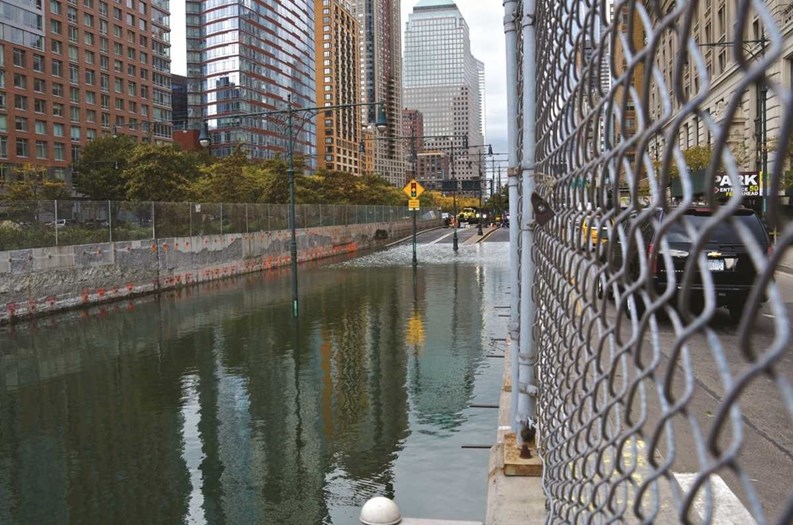Fires devastated Breezy Point; areas of Staten Island were destroyed with lives lost; thousands of residents in Lower Manhattan were plunged into darkness after an electrical transformer exploded on the East River. These events were among the horrific results of Superstorm Sandy, an event that continues to haunt countless New York residents nearly eight months after the storm surge.
“As with most victims, they feel relief is slow and not enough,” says Greg Carlson, executive director of the Federation of New York Housing Cooperatives & Condominiums (FNYHC). “The process is so slow that many without the means feel helpless.”
The superstorm is being blamed for roughly $70 billion in damage and other losses, the vast majority of which was in New Jersey and New York. Hitting two days shy of Halloween, Sandy is the second-costliest storm in U.S. history after 2005’s Hurricane Katrina laid waste to New Orleans.
“As we all have seen, certain areas of New York City were hit harder by Sandy than others, and some residents have been disappointed by the slow political machines that determined various recovery activities,” says Michael Berenson, president of Manhattan-based AKAM Living Services. “AKAM cannot speak to the political issues that have arisen in Sandy’s wake, nor to the overall mood in the city, but we can however address the responses we have gotten from the properties under our management that were impacted, which have been overwhelmingly positive.”
Oscar Wilde once said, “Experience is one thing you can’t get for nothing.” And while no person, state or entity wants to endure a storm the magnitude of Sandy, prior weather-related crises served as an education. Elected officials are learning as they move forward, including New York State Governor Andrew Cuomo, who many months after the storm has pledged that rebuilding efforts will continue.
“I directed state agencies, including Division of Homeland Security and Emergency Services and the Department of Environmental Conservation to work with their federal and local counterparts to make beach and coastal restoration a priority in our effort to protect and secure our vulnerable coastline and nearby residential neighborhoods,” Governor Cuomo said in early March. “Recovering from Sandy, rebuilding our communities, protecting our citizens and strengthening our natural coastal barriers have to be done intelligently and in a coordinated fashion. This work also has to be done as quickly as possible, ensuring that we rebuild smarter and stronger.”
Are HOAs Adrift?
Immediate impacts of the storm were far reaching with many communities experiencing power loss for weeks and public services such as the MTA and PATH services frozen. As days turned into weeks and then months, crews worked round the clock to repair the unprecedented damage. During this scramble, many affected residents were confused as to what they were entitled to from the government as well from respective insurance agencies.
“The CNYC is working through the National Association of Housing Cooperatives to change the way the Federal Emergency Management Agency (FEMA) regards cooperatives and condominiums,” says Mary Ann Rothman, the executive director of the Council of New York Cooperatives and Condominiums (CNYC). “We believe that we should be eligible for FEMA grants to rebuild building-wide systems or clear debris from areas such as lawns and campuses. FEMA presently considers us to be business enterprises and therefore not eligible for grants; however, individuals still qualify for FEMA grants to repair the insides of their units.”
Carlson further explains that cooperatives, condominiums and HOAs are not recognized by FEMA as having common home ownership elements. Having them viewed as business entities, ineligible for FEMA relief, building administrators and managers are being directed to the Small Business Administration (SBA) for loans.
“The National Association of Housing Cooperatives (NAHC) have partnered up with the National Cooperative Business Association (NCBA) and the Community Associations Institute (CAI) to urge FEMA that they have misinterpreted the Sanford Act and that these co-op, condos and HOAs are in fact homeowners,” says Carlson. “In addition, this group has been pursuing legislation correcting this misinterpretation. Senator [Charles] Schumer has asked HUD to deliver block grants to the affected areas.”
Throughout the rebuilding efforts, politicians have been both praised and scorned for their respective efforts. Schumer has stepped up to the plate to assist storm-damaged co-ops and condos so that homeowners can receive a portion of the estimated $60 billion Sandy relief package. The U.S. Department of Housing and Urban Development (HUD) had allotted $1.77 billion of the federal aid to New York City, which is charged with dispersing the funds.
In mid-February, the senator sent a letter to HUD urging the agency to create programs to help co-ops and condos. “Condos and co-ops should be eligible for the same assistance as single-family homes, and to say one can receive aid while the other can’t makes no sense,” Schumer wrote. “The federal government should allow some of the funds from the Sandy aid bill to right this wrong.”
The monies could aid properties such as the Dayton Beach Park co-op located in the Rockaways. After the storm, the approximate 1,150-unit complex was flooded losing its boilers, water pumps, hot water heaters and laundry room. The neighboring Glen Oaks Village co-op, which has roughly 3,000 units, realized $300,000 in damages.
“In multi-family residences, hundreds upon hundreds of people were affected when the buildings in which they lived became perilous or uninhabitable owing to flooding and/or lost power. The danger was enhanced in multi-family buildings because most have all or most of their mechanical systems below grade whereas basement components may not be in evidence in single-family homes,” says AKAM’s Doug Weinstein, director of operations and compliance for the Manhattan-based property management company. “The management of a multi-family high-rise is certainly a larger and more complex project in a storm such as Sandy. All logistics are multiplied manifold because of the number of people involved, and all must be addressed in real time, from communicating with as many residents as possible, to ensuring the availability of water to assisting with evacuation and return.”
Government Oversight
With New Jersey being hit as hard as New York, governors crossed party lines and worked in a concerted effort to ensure relief was realized. New Jersey Governor Chris Christie even put politics aside and acknowledged the support of the Federal government.
It is in the same spirit that residents and businesses banded together in an effort to rebuild and move forward despite considerable odds. “An AKAM-managed property in the Financial District was among the first, if not the first, of the heavily-impacted buildings in that neighborhood to be made habitable again after evacuation,” says Berenson.
While the sense of community is strong throughout New York, rebuilding efforts for many, including HOAs, have hit snags-from insurance claims to the ability to rebuild whether or not funds are in place. Carlson encourages New York residents to reach out to their congressional representative for assistance. “We can’t do it alone and we need you to help us urge your members of congress to contact FEMA and the Department of Homeland Security to urge them to allow our housing cooperatives to be included in all the relief provided to other homeowners,” he notes.
This is not only a point of contention for HOA advocates; it has caused gridlock and frustration. “All we’re able to do is ask, and to amass support for our request,” says Rothman. “We have no ability to dictate any kind of date to FEMA.” To this end, FEMA has not yet released information related to these request.
What About Next Time?
Referring back to the wisdom of Oscar Wilde, there is a silver lining to Superstorm Sandy in that lessons were learned and new policies are in place to better prepare residents, utility companies, businesses and organizations.
“In the wake of Sandy, we are already seeing changes in the industries that serve our managed properties. For example, building codes are being strengthened and insurance is going to be tailored to address unique flooding and other circumstances,” says Weinstein. “We also will be seeing changes in where buildings are placing or replacing their mechanical components so that they are no longer as vulnerable as they were when in basements that good flooded. Many buildings are also purchasing and storing inventories of emergency supplies like flashlights and water and are looking into the advisability and cost variables for purchasing and installing emergency generators.”
AKAM advocates that all buildings provide detailed storm protocol instructions to every superintendent, board member, owner and resident. “From our perspective, the best thing a board can do is make sure that the building is being served by a management company that takes a proactive approach to emergency response, that doesn’t close down when a few clouds appear in the sky and that makes sure that the building returns to normal as quickly as possible in the aftermath,” says Weinstein.
As New York welcomes spring, many residents are still trying to rebuild their respective lives. It remains a long, arduous road. While there are many success stories, there are also those left disappointed and shattered. “At this point, condo and HOA residents are left on their own,” says Carlson. “If they are in a governmental program, there is some relief by government.”
W.B. King is a freelance writer and a frequent contributor to The Cooperator.







Leave a Comment